UK blogger detained in Baikonur confirms release from custody after issued fine
Tuesday, 10 May 2022 01:10 UK blogger Benjamin Rich, who was recently detained near a launch pad in the Baikonur spaceport, said on Sunday that the Russian police released him after questioning and handed out a fine.
On Saturday, Roscosmos chief Dmitry Rogozin said that UK citizen Benjamin Rich and a Belarusian citizen Alina Zelupa were detained during unauthorised passage near the 112 launch pad in Baikonur and tak
UK blogger Benjamin Rich, who was recently detained near a launch pad in the Baikonur spaceport, said on Sunday that the Russian police released him after questioning and handed out a fine.
On Saturday, Roscosmos chief Dmitry Rogozin said that UK citizen Benjamin Rich and a Belarusian citizen Alina Zelupa were detained during unauthorised passage near the 112 launch pad in Baikonur and tak NASA's InSight Records Monster Quake on Mars
Tuesday, 10 May 2022 01:10 NASA's InSight Mars lander has detected the largest quake ever observed on another planet: an estimated magnitude 5 temblor that occurred on May 4, 2022, the 1,222nd Martian day, or sol, of the mission. This adds to the catalog of more than 1,313 quakes InSight has detected since landing on Mars in November 2018. The largest previously recorded quake was an estimated magnitude 4.2 detected Aug.
NASA's InSight Mars lander has detected the largest quake ever observed on another planet: an estimated magnitude 5 temblor that occurred on May 4, 2022, the 1,222nd Martian day, or sol, of the mission. This adds to the catalog of more than 1,313 quakes InSight has detected since landing on Mars in November 2018. The largest previously recorded quake was an estimated magnitude 4.2 detected Aug. Sliding Into the Weekend Like - Sols 3466-3468
Tuesday, 10 May 2022 01:10 It's been a challenging week in Gale crater, but Curiosity and the rover team are ready to put those challenges behind us as we head into a busy weekend plan. I've been on shift as LTP and SOWG Chair this week, and we've had a handful of issues related to difficult terrain, being in a good orientation for communication, and having small downlink volumes available for planning.
Today was a
It's been a challenging week in Gale crater, but Curiosity and the rover team are ready to put those challenges behind us as we head into a busy weekend plan. I've been on shift as LTP and SOWG Chair this week, and we've had a handful of issues related to difficult terrain, being in a good orientation for communication, and having small downlink volumes available for planning.
Today was a Rocket Lab launches BRO-6 for Unseenlabs
Tuesday, 10 May 2022 01:10 Unseenlabs, the European leader in radio frequency (RF) signals detection from space, successfully launched its seventh satellites dedicated to the geolocation of vessels at sea on may 3, with rocket lab launcher. In total, Unseenlabs has deployed seven satellites since 2019 and will launch other satellites in 2022.
Unseenlabs' constellation is designed to provide clients with data to foll
Unseenlabs, the European leader in radio frequency (RF) signals detection from space, successfully launched its seventh satellites dedicated to the geolocation of vessels at sea on may 3, with rocket lab launcher. In total, Unseenlabs has deployed seven satellites since 2019 and will launch other satellites in 2022.
Unseenlabs' constellation is designed to provide clients with data to foll Plans unveiled to better connect space industries in Scotland and the UAE
Tuesday, 10 May 2022 01:10 Globally focused strategic space marketing firm AstroAgency, headquartered in Edinburgh, has announced it will team up with a Dubai-based space investment and advisory company AzurX, to support space businesses in both regions, access new development opportunities and forge collaborative partnerships.
The two organisations boast a global space client base, with AzurX acting as the trusted
Globally focused strategic space marketing firm AstroAgency, headquartered in Edinburgh, has announced it will team up with a Dubai-based space investment and advisory company AzurX, to support space businesses in both regions, access new development opportunities and forge collaborative partnerships.
The two organisations boast a global space client base, with AzurX acting as the trusted China launches the Tianzhou 4 cargo spacecraft
Tuesday, 10 May 2022 01:10 In the latest stage in its space station program, China launched the Tianzhou 4 cargo spacecraft early on Tuesday morning, to transport fuel and supplies to its Tiangong space station, according to the China Manned Space Agency, or CMSA.
In a brief statement, the agency said that a Long March 7 carrier rocket blasted off from the Wenchang Space Launch Center in Hainan province at 01:56 am,
In the latest stage in its space station program, China launched the Tianzhou 4 cargo spacecraft early on Tuesday morning, to transport fuel and supplies to its Tiangong space station, according to the China Manned Space Agency, or CMSA.
In a brief statement, the agency said that a Long March 7 carrier rocket blasted off from the Wenchang Space Launch Center in Hainan province at 01:56 am, JWST entering “home stretch” of commissioning
Tuesday, 10 May 2022 00:19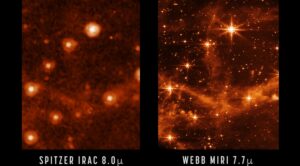
The James Webb Space Telescope is operating better than expected as the spacecraft enter the final stages of commissioning, project officials said May 9.
The post JWST entering “home stretch” of commissioning appeared first on SpaceNews.
Globalstar agrees terms with “global customer” for terrestrial connectivity
Monday, 09 May 2022 21:20
Globalstar has signed a term sheet with a “large, global customer” to start deploying some of its spectrum for terrestrial use “in the U.S. and beyond,” the satellite operator said May 5.
The post Globalstar agrees terms with “global customer” for terrestrial connectivity appeared first on SpaceNews.
Webb telescope's first full color, scientific images coming in July
Monday, 09 May 2022 16:40
Get ready for a summer blockbuster.
The James Webb Space Telescope will produce "spectacular color images" of the cosmos in mid-July—its first observations dedicated to its mission of scientific discovery, an astronomer overseeing the project said Monday.
The successor to Hubble has spent the last five months aligning its instruments in preparation for the big reveal, with scientists deliberately remaining coy about where the cameras will be pointed.
"We'd really like it to be a surprise," Klaus Pontoppidan, a scientist at the Space Telescope Science Institute in Baltimore told reporters, adding that the secrecy was partly due to the first targets not yet being finalized.
NASA and its partners the European Space Agency (ESA) and Canadian Space Agency (CSA) formed a committee to create a ranked list of objects, which they now intend to work through.
South Korea’s new president seeks independent space agency, deeper US space cooperation
Monday, 09 May 2022 14:52
South Korea’s newly elected president Yoon Suk-yeol will take office May 10 with a set of ambitious space projects aimed at making the country a major space power by 2035.
The post South Korea’s new president seeks independent space agency, deeper US space cooperation appeared first on SpaceNews.
Op-ed | A comprehensive triad for space resilience – more than just numbers
Monday, 09 May 2022 14:05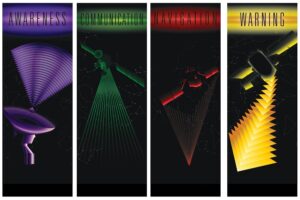
To meet the threat to U.S. space systems, DoD needs to broaden its approach to resilience to fully embrace reconstitution.
The post Op-ed | A comprehensive triad for space resilience – more than just numbers appeared first on SpaceNews.
MIRI’s sharper view hints at new possibilities for science
Monday, 09 May 2022 13:30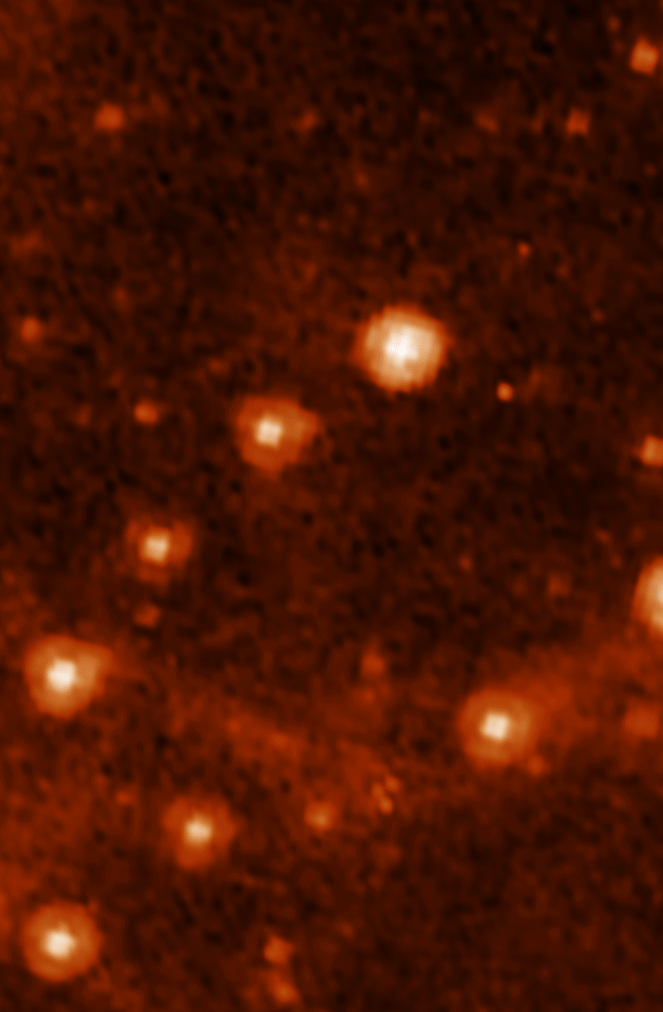 Image:
Image:
Click here to download the images used in this gif.
The James Webb Space Telescope is aligned across all four of its science instruments, as seen in a previous engineering image showing the observatory’s full field of view. Now, we take a closer look at that same image, focusing on Webb’s coldest instrument: the Mid-Infrared Instrument, or MIRI.
The MIRI test image (at 7.7 microns) shows part of the Large Magellanic Cloud. This small satellite galaxy of the Milky Way provided a dense star field to test Webb’s performance.
Here, a close-up of the MIRI image is compared
MIRI and Spitzer comparison image
Monday, 09 May 2022 13:30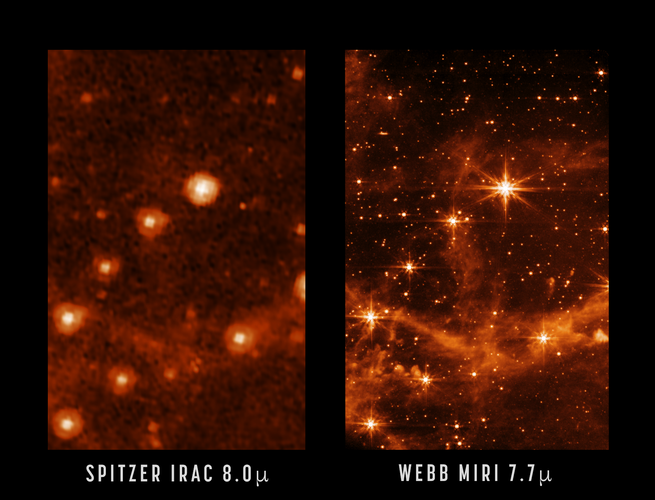 Image:
Image:
Click here to download the gif.
The James Webb Space Telescope is aligned across all four of its science instruments, as seen in a previous engineering image showing the observatory’s full field of view. Now, we take a closer look at that same image, focusing on Webb’s coldest instrument: the Mid-Infrared Instrument, or MIRI.
The MIRI test image (at 7.7 microns) shows part of the Large Magellanic Cloud. This small satellite galaxy of the Milky Way provided a dense star field to test Webb’s performance.
Here, a close-up of the MIRI image is compared to a past image
What does micrometeoroid damage do to gossamer structures like Webb's sunshield?
Monday, 09 May 2022 13:23
Tiny little bullets flood the solar system, each micrometeoroid a potential hazard. New research has found that the James Webb Space Telescope's thin sunshields, and future inflatable spacecraft, may be at risk.
A micrometeoroid is a tiny bit of space junk usually weighing less than a gram. Some of them are the leftover bits of the countless collisions that have occurred over the past 4.5 billion years of the history of the solar system. Most, however, come from the dust cloud that initially collapsed to form our solar system, and never got to be a part of a larger body.
CACI to launch experimental satellite to demonstrate alternative to GPS navigation
Monday, 09 May 2022 12:58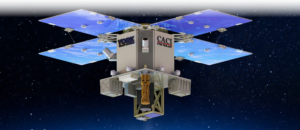
CACI International is funding an experiment to demonstrate space technologies for military use, including an alternative to GPS navigation.
The post CACI to launch experimental satellite to demonstrate alternative to GPS navigation appeared first on SpaceNews.

